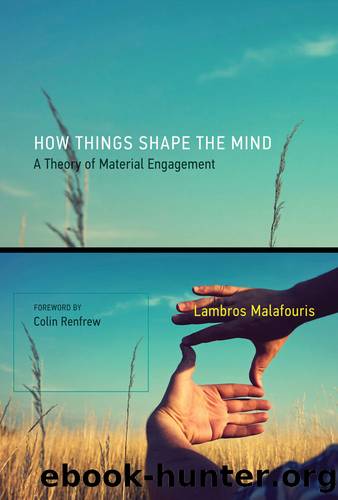How Things Shape the Mind by Malafouris Lambros

Author:Malafouris, Lambros [Malafouris, Lambros]
Language: eng
Format: epub
ISBN: 9780262315678
Publisher: MIT Press
Published: 2013-07-12T00:00:00+00:00
III
Marking the Mental: Where Brain, Body, and Culture Conflate
7
Knapping Intentions and the Handmade Mind
Minds like ours were made for mergers. Tools-R-Us, and always have been.
âAndy Clark (2003, 7)
Homo faber : Prosthetic gestures
A fundamental theme that cognitive archaeology shares with philosophical anthropology when it comes to understanding what it is to be human is, of course, the theme of the tool-making and tool-using abilities of humans. Tool making, as the prototypical exemplar of what in this book I call the process of material engagement, provides a unique means of understanding how mental events relate to matter and project to the world. Beyond that, the beginning of early-hominin stone flaking, as documented in the archaeological record approximately 2.7 million to 2.5 million years ago (Semaw 2000), may have been an important threshold in the prehistory of mind. For many, this form of embodied mediated action and its products defines the genus Homo , the descent of âman the toolmaker.â (See Ambrose 2001.)
No other species has been or can be defined as a species on the basis of its relationship with tools and material culture. We humans are precisely a species of this rather strange sort, i.e., Homo faber . In contrast to the prevalent cognitivist, intracranialist, executive, modernist, or sapient definition, I think that Homo faber still provides the best predicate for what it means to be human. We came to have a sapient mind because we are Homo faber . Of course, what distinguishes us from other animals is not so much that we make and use tools. Other animals seem to be capable of that to some degree. Yet, despite the famous feats of termite-fishing chimpanzees and hook-crafting crows (for a review of the evidence, see Seed and Byrne 2010 or Tomasello and Herrmann 2010), Henri-Louis Bergsonâs words in his book Creative Evolution remain largely unchallenged:
If we could rid ourselves of all pride, if, to define our species, we kept strictly to what the historic and the prehistoric periods show us to be the constant characteristic of man and of intelligence, we should say not Homo sapiens , but Homo faber . In short, intelligence, considered in what seems to be its original feature, is the faculty of manufacturing artificial objects, especially tools to make tools, and of indefinitely varying the manufacture . (1998 [1911], 139)
I am not questioning that nonhuman animals and especially primates also use a variety of tools for a variety of purposes, including subsistence and display. (See, e.g., Boesch and Boesch 1984; Boesch et al. 1994; Goodall 1964; Whiten et al. 1999, 2009.) I am saying thatâeven if we look at the most sophisticated examples of animalsâ tool use, as in the putative scenario of the reuse of a stone hammer from one year to the next (Boesch and Boesch 1984)âthe room for meaningful comparisons with humans is very limited. Even the most highly trained nonhuman nut crackers couldnât equal the abilities seen in the earliest hominin makers of stone tools (Davidson and McGrew 2005; Iriki and Sakura 2008).
Download
This site does not store any files on its server. We only index and link to content provided by other sites. Please contact the content providers to delete copyright contents if any and email us, we'll remove relevant links or contents immediately.
| Africa | Americas |
| Arctic & Antarctica | Asia |
| Australia & Oceania | Europe |
| Middle East | Russia |
| United States | World |
| Ancient Civilizations | Military |
| Historical Study & Educational Resources |
Never by Ken Follett(2912)
Machine Learning at Scale with H2O by Gregory Keys | David Whiting(2323)
The Man Who Died Twice by Richard Osman(2312)
Fairy Tale by Stephen King(2098)
Will by Will Smith(2073)
Rationality by Steven Pinker(1775)
The Dark Hours by Michael Connelly(1585)
The Dawn of Everything: A New History of Humanity by David Graeber & David Wengrow(1580)
Principles for Dealing With the Changing World Order: Why Nations Succeed and Fail by Ray Dalio(1389)
Friends, Lovers, and the Big Terrible Thing by Matthew Perry(1349)
A Short History of War by Jeremy Black(1307)
HBR's 10 Must Reads 2022 by Harvard Business Review(1262)
Go Tell the Bees That I Am Gone by Diana Gabaldon(1248)
Can't Hurt Me: Master Your Mind and Defy the Odds - Clean Edition by David Goggins(1243)
515945210 by Unknown(1219)
Fear No Evil by James Patterson(1119)
443319537 by Unknown(1081)
Works by Richard Wright(1024)
Going There by Katie Couric(999)
